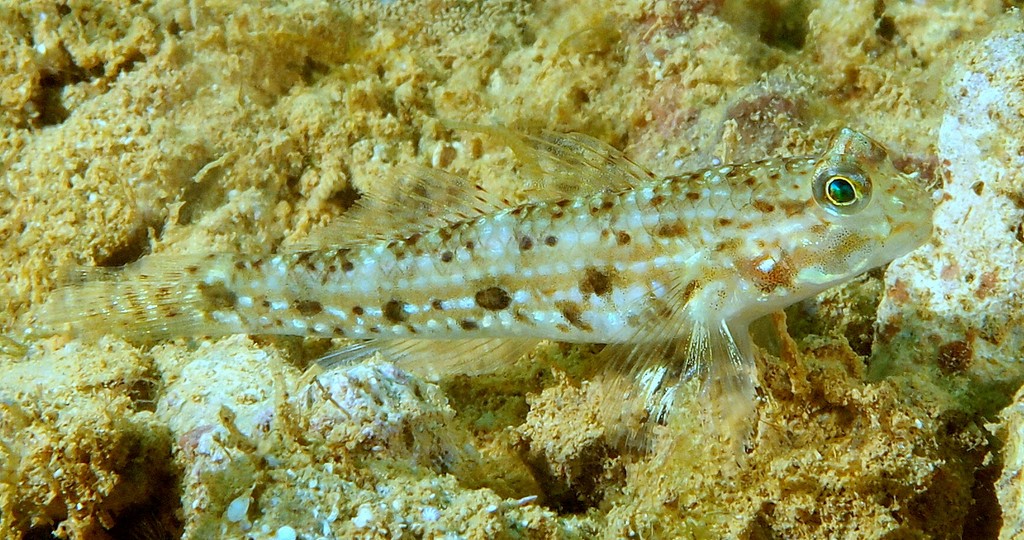ISTIGOBIUS NIGROOCELLATUS - (GUNTHER, 1873)
Actinopterygii (Gigaclass) > Actinopteri (Class) > Teleostei (Subclass) > Gobiiformes (Order) > Gobioidei (Suborder) > Gobiidae (Family) > Gobiinae (Subfamily) > Istigobius (Genus)
Gobie à points noirs, Black-spotted goby, Black-spotted sand-goby, Blackspotted sandgoby, Oki-kazarihaze, オキカザリハゼ,
Synonymes
Gobius nigroocellatus (Günther, 1873)
Innoculus nigroocellatus (Günther, 1873)
---------------------
Description
Dorsal spines (total): 7; Dorsal soft rays (total): 10-12; Anal spines: 1; Anal soft rays: 9-11; Vertebrae: 26; Longitudinal scale series: 30-32; Depth of body: 4.8-5.8 in SL. Upper pectoral fin rays entire. Trunk scales ctenoid, predorsal cycloid. In male, anal fin dusky and when appressed, reaching or almost reaching caudal fin, appressed dorsal fin overlapping caudal fin. In female, appressed anal and dorsal fins extending within 1-2 scales from caudal. Max. length: 6.5 cm SL (male), 5.5 cm TL (female). Depth range: 2 - 10 m.
Gobie à points noirs, Black-spotted goby, Black-spotted sand-goby, Blackspotted sandgoby, Oki-kazarihaze, オキカザリハゼ,
Synonymes
Gobius nigroocellatus (Günther, 1873)
Innoculus nigroocellatus (Günther, 1873)
---------------------
Description
Dorsal spines (total): 7; Dorsal soft rays (total): 10-12; Anal spines: 1; Anal soft rays: 9-11; Vertebrae: 26; Longitudinal scale series: 30-32; Depth of body: 4.8-5.8 in SL. Upper pectoral fin rays entire. Trunk scales ctenoid, predorsal cycloid. In male, anal fin dusky and when appressed, reaching or almost reaching caudal fin, appressed dorsal fin overlapping caudal fin. In female, appressed anal and dorsal fins extending within 1-2 scales from caudal. Max. length: 6.5 cm SL (male), 5.5 cm TL (female). Depth range: 2 - 10 m.
Color
Three spots forming a `V' on caudal base; Black spot basally between dorsal spines 5-6; Pectoral base, cheek and operculum with many dusky melanophores; Pelvic fins black. Longitudinal black bar off distal part of upper jaw.
Etymology
Istigobius: from Greek, istios = sail + from Latin, gobius = gudgeon.
nigroocellatus: from Latin, niger = shining black + from Latin, ocellatus = having small eyes or an eyelike marking in the form of a spot or ring of color, as on the wing of a butterfly or the tail of a peacock.
Original description: Gobius nigroocellatus Günther, 1873 - Type locality: Bowen, Queensland, Australia.
Distribution
Eastern Indian Ocean, western Pacific: Malaysia and Indonesia east to Philippines, New Ireland (Papua New Guinea) and Solomon Islands, south to Queensland (Australia) and New Caledonia.
Biology
Found in shallow coastal sand flats, usually silty bottom in a few meters depth. Genital papilla of male pigmented, terminating to side of anal spine. Female genital papilla slightly pigmented, truncate, and terminating well before anal fin origin.
Similar species
Fishes in the genera Bathygobius can be easily confused with those of Istigobius. The main difference is the overhanging snout in Istigobius. Bathygobius has larger elongate dark spots on the midside and numerous small white spots (Istigobius has white lines, but no spots). Istigobius tends to have brighter colours, with Bathygobius being black, brown and white.
Istigobius: from Greek, istios = sail + from Latin, gobius = gudgeon.
nigroocellatus: from Latin, niger = shining black + from Latin, ocellatus = having small eyes or an eyelike marking in the form of a spot or ring of color, as on the wing of a butterfly or the tail of a peacock.
Original description: Gobius nigroocellatus Günther, 1873 - Type locality: Bowen, Queensland, Australia.
Distribution
Eastern Indian Ocean, western Pacific: Malaysia and Indonesia east to Philippines, New Ireland (Papua New Guinea) and Solomon Islands, south to Queensland (Australia) and New Caledonia.
Biology
Found in shallow coastal sand flats, usually silty bottom in a few meters depth. Genital papilla of male pigmented, terminating to side of anal spine. Female genital papilla slightly pigmented, truncate, and terminating well before anal fin origin.
Similar species
Fishes in the genera Bathygobius can be easily confused with those of Istigobius. The main difference is the overhanging snout in Istigobius. Bathygobius has larger elongate dark spots on the midside and numerous small white spots (Istigobius has white lines, but no spots). Istigobius tends to have brighter colours, with Bathygobius being black, brown and white.
